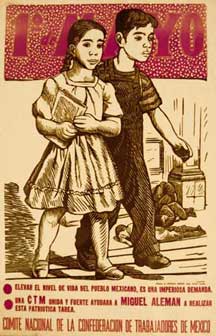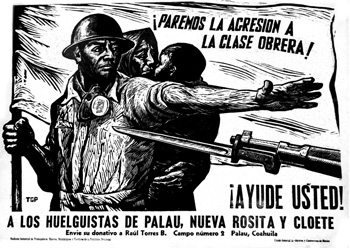
This page is an author-published HTML version of the PDF review that
appears in A Contracorriente, Vol. 5, No. 3, Spring 2008,
257-262; www.ncsu.edu/project/acontracorriente
page updated 4/23/2021
Review/Reseña
Deborah Caplow, Leopoldo Méndez: Revolutionary Art
and the Mexican Print.
Austin: University
of Texas Press, 2007.
Print Art and Revolution in Mexico
Lincoln Cushing, Art Historian
Although Mexico’s contribution to social-movement murals is well
documented, much less is known about Mexico’s activist graphic arts
history. Leopoldo Méndez (1902-1969) was a printmaker and activist in
numerous political and artistic groups, but he reached his incandescent
peak as founding member and de-facto leader of the Taller de Gráfica
Popular (variously translated as Popular Graphic Arts Workshop or
People’s Graphic Art Workshop, TGP). It is a resounding tragedy that
the TGP, one of the most significant loci of mid-20th century social
movement printmaking, is virtually unknown in the United States. This
is only partly explained by the usual disability of Anglocentrism; the
deeper roots have to do with academia’s discomfort with political
activism and with the general lack of scholarship in this country about
political printmaking. Deborah Caplow’s excellent book goes a long way
toward informing us about the explosive combination of art, artists,
politics, and printmaking in Mexico during the mid-1900s. More than any
previous work, Caplow’s book explains Méndez in the context of his
time, analyzed through the organizations in which he participated and
the other artists with whom he collaborated.
 “Primero de mayo—CTM 1947”, linocut. From the collection of the Bancroft Library, University of California, Berkeley |
Mexico has a long history of
printmaking in the service of social change, largely credited to the
seminal work of José Guadalupe Posada (1852-1913), who was a printmaker
and social critic during the Mexican Revolution. The TGP was founded in
late 1937 after the collapse of the four year old Liga de Escritores y
Artistas Revolucionarios (LEAR, Revolutionary Writers’ and Artists’
League). It brought together a dedicated cadre of political activists
who happened to express themselves as printmakers. They worked
collaboratively, issued editions as both fine-art prints for raising
funds and free or cheap street posters for propaganda, and engaged in
strategic acts of support for progressive candidates and issues.
Although they occasionally generated lithographs, screenprints, and
other media, their trademark expression was through linocuts –one or
two color relief prints created from hand cut linoleum mounted on
blocks. Prints were generally single sheet items, although some works
are quite large for this medium (35 x 90 cm) and some were printed as
two sheets and pasted together into one large poster.
The TGP created exemplary images on such social justice topics as land
reform, progressive electoral candidates, anti-war and anti-imperialist
movements, opposition to fascism in Japan and Germany, solidarity with
foreign struggles, folk life, labor and trade unions, Mexican
revolutionary history and heroes, and other progressive causes. The
Taller became a magnet in the progressive design community, and several
resident and guest U.S. artists (including Elizabeth Catlett, Pablo
O’Higgins, and Mariana Yampolsky) produced work there. In fact, the
constant ebb and flow between the U.S. and Mexico of artists,
commissions, and exhibits was one of the TGP’s manifestations of
artistic internationalism.
The absence of published
material on what is arguably the single
most significant graphics workshop in the Americas is profound and
perplexing. The University of New Mexico, which holds a sizable
collection
of TGP prints and ancillary documents, planned the publication of an
anthology in 2005, but the project was never completed. The
Philadelphia
Museum of Art produced the exhibit “Mexico and Modern Printmaking: A
Revolution in the Graphic Arts, 1920 to 1950” in 2007. The core of this
exhibit was prints from the TGP, and resulted in a lavishly-illustrated
catalog with an essay on the TGP and several on participating artists.
But
most scholarship on the Taller is buried in a handful of unpublished
doctoral theses.
Organized chronologically, Caplow’s book traces Méndez’ prolific
and influential trajectory, noting artistic and political influences
that
affected his practice. The artistic inspirations were both domestic
(Posada,
of course, at the top) as well as North American (Thomas Nast) and
European (Käthe Kollwitz and John Heartfield). Although there is a deep
link with refugees from the U.S. Works Progress Administration, there
is
less documented evidence or analysis of artistic influences being
swapped
with other Caribbean or Latin American countries. (Such links
exist—recently deceased Puerto Rican painter and printmaker Rafael
Tufiño was born in Brooklyn and went to art school in Mexico under the
G.I. Bill, where he studied under several TGP printmakers). Caplow
notes
that Méndez was the first of that generation’s Mexican graphic artists
to
emulate (and later expand upon) Posada’s iconography and satiric visual
approach, reintroducing the fundamentally Mexican image of the
calavera.
 “Paremos la agresión a la clase obrera!” 1950,
linocut. From the collection
of the Bancroft Library, University of California, Berkeley. “Paremos la agresión a la clase obrera!” 1950,
linocut. From the collection
of the Bancroft Library, University of California, Berkeley. |
Méndez expressed himself in many media. He produced some murals, and although the published text states that all of them appear to have been lost, Caplow was pleased to find out that it turns out the murals painted by Méndez, Zalce and O’Higgins at the National Printers’ Workshops has been rediscovered and reinstalled at the UNAM in 2007. He also published essays on Mexican art and culture. But, starting with woodcut prints in 1925, he quickly embraced the democratic possibilities of printmaking. Caplow points out that rather than employing a simply iconic treatment, Méndez often integrated narrative text into his imagery in the form of background banners and captions.
Caplow also uses Méndez’ experiences to explore some of the challenges faced anywhere by political arts groups operating under capitalism. How shall collective work be balanced by individual work? How much work should be done for free or cheap as propaganda versus high- priced fine art prints for sale at galleries? To what extent does it hurt or help the Taller to become affiliated with a specific political candidate or party? In which sort of major equipment should a “people’s workshop” invest, and what are the political consequences of such choices? Caplow treats us with Mendez’ observations on this issue, as observed later in his life in 1963:
| …To me it
[getting an offset press] has always been and continues to be a worthy
idea, but it does not fit into the reality of the Taller. A machine of
this type prints four thousand copies an hour. In one day of work one
could run a great quantity of drawings given that five, six, seven
drawings can be printed on one plate. That is to say in one hour—if one
makes four prints in one plate—sixteen thousand copies of a print can
be printed. This requires a very efficient apparatus of distribution
such as belongs to a big business, and we have never been big
businessmen! In addition, a machine can not be idle; it is necessary
for it to work constantly to justify its existence and to pay for
itself. Neither are artists going to run it. It would be absurd to ask
artists to manage it themselves. For this reason I am against the
mechanization of the Taller as it is today. [from “Los 60 años de Leopoldo Méndez,” by Elena Poniatowska, in Artes de Mexico, July 1963.] |
Readers unfamiliar with
printmaking techniques will not learn
much about nuances of the media in this text. The Mexican graphic
artists
appropriated a wide range of methods, each involving different levels
of
artistic skill, adaptability, and cost. The TGP even developed a
domestic
variant of this process known as “suelografía,” using the cheaper
industrial
material “Neolite” manufactured for shoes and sandals. And
unfortunately,
the economics of modern publishing has limited the visual
wealth—although here are sixteen pages of color reproductions, and many
of the images presented were black and white to begin with, still many
of
the images presented lose some of their impact when devoid of their
original coloration, and no notation is offered to indicate which ones
suffered this cut.
But these are minor concerns. The book was researched with care,
and includes fourteen interviews that bring the immediacy of
participants
voices into the mix. It is also meticulously footnoted, with an
extensive
bibliography and index. The author also did an excellent job of
personally
photodocumenting a large body of material encountered in her research
and fieldwork. The aggregate whole of this book—the illustrations,
research, and original analysis—makes it an essential resource for
anyone
trying to understand the dynamic and stirring history of Mexico’s
graphic
art tradition.
______________________________________________________________________________________________
Lincoln Cushing es investigador, autor e
impresor. Hace poco procesó la colección
del
TGP (Taller de Gráfica Popular) para la Biblioteca Bancroft en
Berkeley. Sus libros
incluyen Revolución!
Cuban Poster Art (autor, 2003), Visions of Peace &
Justice: 30
years of political posters from the archives of Inkworks Press (editor,
2007), Chinese
Posters: Art from the Great Proletarian Cultural Revolution
(co-autor, 2007), y
Art/Works—American
Labor Posters (co-autor), que Cornell University Press
publicará
en 2009. Ver su página en internet: www.docspopuli.org